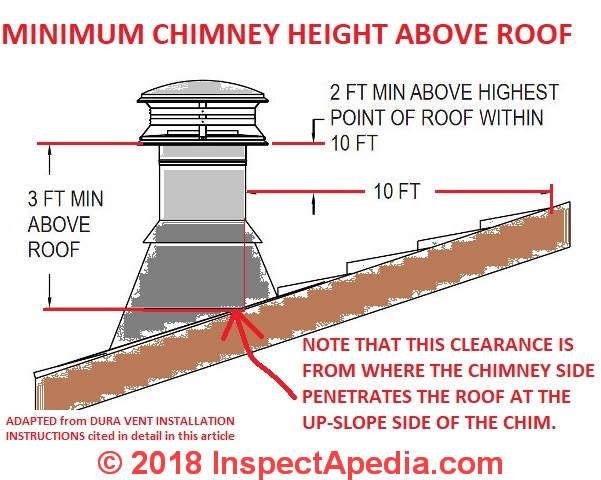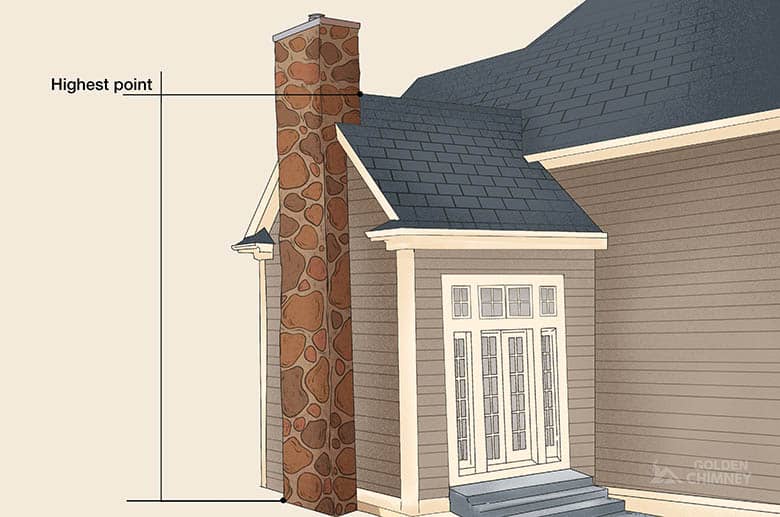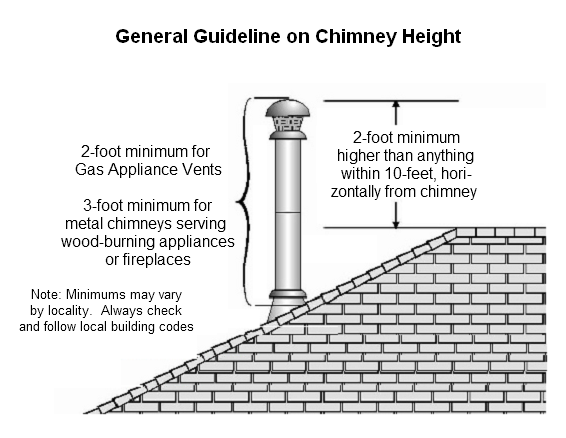How High Should A Chimney Be Above A Roof

Frequently Asked Questions: Chimney Height Above Roof
Ensuring your chimney is the correct height above your roof is crucial for safe and efficient venting of smoke and combustion byproducts. An improperly sized chimney can lead to dangerous situations, including carbon monoxide poisoning and chimney fires. This FAQ addresses common questions about determining the proper chimney height.
Q1: Why is Chimney Height Above the Roof Important?
The height of your chimney significantly impacts its ability to create proper draft. Draft is the flow of air up the chimney, pulling smoke and combustion gases away from your fireplace or appliance and safely out of your home. Insufficient chimney height can result in:
- Backdrafting: Smoke and gases entering your home instead of exiting.
- Poor Appliance Performance: Reduced heating efficiency and potential damage to your appliance.
- Increased Risk of Chimney Fires: Creosote buildup due to poor draft.
- Carbon Monoxide Poisoning: A potentially fatal risk if combustion byproducts aren't vented properly.
Adequate chimney height ensures proper draft, promoting safe and efficient operation of your fireplace or heating appliance.
Q2: What is the "3-2-10 Rule" for Chimney Height, and How Does It Work?
The "3-2-10 Rule" is a widely accepted guideline for determining minimum chimney height. It states:
- The chimney must extend at least 3 feet above the highest point where it penetrates the roof.
- The chimney must be at least 2 feet higher than any portion of the roof within a 10-foot horizontal radius.
Breaking it down:
- 3 Feet Above the Penetration Point: This is a fundamental requirement. Measure from the point where the chimney exits the roof to the top of the chimney.
- 2 Feet Above Anything Within 10 Feet: Imagine drawing a circle with a 10-foot radius around your chimney. The top of your chimney must be at least 2 feet higher than any part of your roof (or any other structure) that falls within that circle.
Example 1: Flat Roof
If you have a flat roof, the "3 feet above the penetration point" rule likely applies. Measure 3 feet from the roof surface to the top of the chimney.
Example 2: Sloped Roof
If your chimney is located near the ridge of a sloped roof, it probably already meets the 3-foot rule. However, the 10-foot rule becomes more important. If the peak of your roof is within 10 feet of the chimney, the chimney must extend at least 2 feet above that peak.
Example 3: Chimney on Lower Section of Roof
If your chimney exits the roof lower down the slope, the 10-foot rule is especially critical. Any part of the roof higher than the chimney and within 10 feet must be considered when determining the necessary chimney height.
Q3: Does the 3-2-10 Rule Apply to All Types of Roofs and Chimneys?
The 3-2-10 rule is a general guideline, but there are situations where it might not be sufficient or might need to be adapted:
- Extremely Steep Roofs: On very steep roofs, the 3-2-10 rule might result in an excessively tall chimney. In such cases, consulting with a qualified chimney professional is recommended. They can assess the specific situation and determine the optimal height based on factors like prevailing wind conditions and local building codes.
- Unusual Roof Configurations: Complex roof designs with dormers, gables, or other obstructions can create challenging airflow patterns. A professional assessment is crucial to ensure proper draft in these situations.
- Nearby Structures: Tall trees, adjacent buildings, or other structures can affect chimney draft. These factors should be considered when determining chimney height, and the 3-2-10 rule might need to be adjusted accordingly. A professional can evaluate the impact of these structures.
- High Wind Areas: In areas with consistently high winds, a taller chimney might be necessary to prevent downdrafts and ensure proper venting.
- Type of Appliance: Some appliances, such as certain types of wood stoves or furnaces, may have specific chimney height requirements specified by the manufacturer. Always consult the appliance's installation manual for guidance.
While the 3-2-10 rule provides a good starting point, it's always best to consult with a qualified chimney professional to ensure your chimney meets all applicable codes and requirements for safe and efficient operation.
Q4: What Happens if My Chimney Doesn't Meet the 3-2-10 Rule?
If your chimney doesn't comply with the 3-2-10 rule (or other applicable building codes), you may experience a range of problems:
- Draft Issues: As mentioned earlier, insufficient chimney height can lead to poor draft, resulting in smoke and gases entering your home.
- Increased Creosote Buildup: Poor draft contributes to creosote buildup in the chimney, increasing the risk of chimney fires. Creosote is a highly flammable substance that forms when combustion byproducts condense inside the chimney.
- Appliance Malfunction: Improper venting can damage your fireplace, wood stove, or furnace.
- Health and Safety Risks: Backdrafting of carbon monoxide poses a serious health hazard and can be fatal.
- Code Violations: Non-compliant chimneys can result in fines or legal issues.
Corrective Actions:
- Chimney Extension: The most common solution is to extend the chimney to meet the required height. This can be done by adding sections of chimney pipe or by installing a taller chimney cap.
- Induced Draft Fan: In some cases, an induced draft fan can be installed to improve airflow in the chimney. This is a mechanical device that helps to pull smoke and gases up the chimney.
- Professional Inspection and Consultation: The first step is to have your chimney inspected by a qualified professional. They can assess the situation, identify the problem, and recommend the appropriate solution.
Q5: Can I Extend My Chimney Myself, or Should I Hire a Professional?
While some homeowners might be tempted to extend their chimney as a DIY project, it's generally strongly recommended to hire a qualified chimney professional. Here's why:
- Safety: Working on a roof can be dangerous, and chimney work often involves heights. Professionals have the necessary safety equipment and experience to perform the job safely.
- Code Compliance: Building codes related to chimney height and construction can be complex. Professionals are familiar with these codes and can ensure your chimney extension meets all requirements.
- Proper Materials and Installation: Using the wrong materials or improper installation can compromise the integrity of your chimney and create safety hazards. Professionals have the knowledge and expertise to select the right materials and install them correctly.
- Warranty and Insurance: Hiring a licensed and insured professional provides you with warranty protection and peace of mind. If something goes wrong, you're covered.
- Diagnosis and Problem Solving: A professional can accurately diagnose the underlying cause of your chimney problems and recommend the most effective solution.
Extending a chimney is not simply a matter of adding pipe. It involves understanding draft dynamics, structural integrity, and safety regulations. For your safety and the longevity of your chimney system, professional installation is highly advisable.
Q6: What is the Role of a Chimney Cap and Does it Affect Chimney Height?
A chimney cap is a protective covering that sits on top of the chimney. While it doesn't directly contribute to the overall height measurement for the 3-2-10 rule, it plays a crucial role in chimney performance and safety:
- Prevents Rain and Snow Entry: This protects the chimney liner and appliance from water damage. Water can corrode the liner and cause significant damage to your fireplace or heating system.
- Keeps Out Animals and Debris: Birds, squirrels, and other animals can build nests in chimneys, blocking airflow and creating fire hazards. Debris like leaves and twigs can also obstruct the chimney.
- Reduces Downdrafts: Some chimney caps are designed to minimize downdrafts caused by wind. These caps help maintain a consistent draft, improving appliance performance.
- Spark Arrestor: Many chimney caps include a spark arrestor screen, which prevents embers from escaping the chimney and potentially starting a fire on the roof or nearby vegetation. This is particularly important in areas prone to wildfires.
Impact on Height:
- The 3-2-10 rule typically refers to the height of the chimney flue, not including the cap. However, some building codes might include the cap in the overall height measurement. Always check your local codes.
- Choosing the right type of chimney cap can indirectly affect chimney performance, which might influence the perceived effectiveness of the chimney height. A well-designed cap can improve draft and reduce downdrafts, making the chimney function more efficiently.
Q7: How Often Should I Inspect My Chimney, and What Should I Look For?
Regular chimney inspections are essential for maintaining safety and preventing problems. The National Fire Protection Association (NFPA) recommends having your chimney inspected at least once a year, even if you don't use your fireplace or heating appliance frequently.
What to Look For:
- Cracks or Damage to the Chimney Structure: Inspect the exterior of the chimney for cracks, crumbling bricks, or other signs of damage.
- Deterioration of the Chimney Liner: The chimney liner protects the chimney walls from heat and corrosion. Look for cracks, gaps, or missing sections of the liner.
- Creosote Buildup: Check for excessive creosote buildup inside the chimney. This can be identified as a black, tar-like substance.
- Obstructions: Look for any obstructions in the chimney, such as bird nests, leaves, or debris.
- Damaged Chimney Cap: Inspect the chimney cap for damage, rust, or missing parts.
- Water Leaks: Look for signs of water leaks around the chimney, such as staining or dampness.
- Unusual Odors: Any unusual odors coming from the chimney could indicate a problem.
Professional Inspection:**
- A certified chimney sweep can perform a thorough inspection of your chimney, including the flue, liner, and firebox. They can identify potential problems that you might not be able to see yourself.
- They will use specialized equipment, such as cameras, to inspect the interior of the chimney and assess the condition of the liner.
- Based on their inspection, they can recommend any necessary repairs or maintenance.
Early detection and prompt attention to chimney problems can prevent costly repairs and, more importantly, protect your home and family from fire and carbon monoxide hazards.










